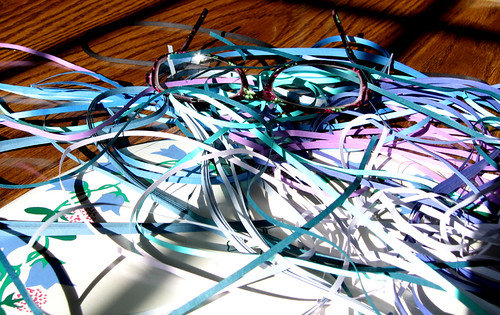Frequently Asked Quilling Questions
I've just started to quill. What kind of paper should a beginner use?
Printer paper cut into 1/8" or 1/4" (roughly 3 or 6mm) strips will be fine for practice. When you're ready for true quilling paper, it's easiest to order it online because you'll find a better selection than in most craft stores. U.S. online quilling suppliers, such as Quilled Creations, The Paper Quilling Shop, and Hunter Creek Crafts, are very good. You can also order strips on Amazon, such as JUYA brand. Here is a starter pack of quilling paper at a reasonable price, and this is a quilling kit that includes tools.
I can't seem to get the hang of quilling. How long does it take to learn?
Quilling is one of those things people think should come very easily just because the supplies are so simple. Rolling paper begins to feel natural after a couple of hours of practice. Not bad for a hobby that may last a lifetime! Feeling all thumbs at first, I had to keep telling myself that if other people could do it, so could I - it's only paper and glue after all.
What type of quilling paper handles best?
There are beautiful options... plain colors, metallic, vellum, parchment, gilded-on-edge, and graduated colors are just some of the choices. Each type handles slightly differently, but all are cut with the paper grain to roll smoothly. Quilling paper is a bit heavier and softer than typical printer paper.
Strips are available in several
widths ranging from "narrow" (about 1/16" or 1.6mm) to 1" (25.4mm), usually marked in mm, (1/8", 3mm is the most common) and many types are packaged in multi-color packs,
as well as single colors.
What quilling tool do you use?
My favorite Japanese precision tool has a super-fine slot... the center crimp that results from the slot is barely noticeable. You can read more about it here. The tool is not available via Etsy shop Quilling Maggie right now due to shipping restrictions. A less expensive alternative is the JUYA fine-tip slotted tool that is sold via Etsy shop, CustomQuillingByLisa and in a set of four on Amazon. Quilled Creations makes a Savvy Slotted Tool that produces almost as small a crimp as the Japanese precision tool and JUYA tool.
What quilling tool do you use?
My favorite Japanese precision tool has a super-fine slot... the center crimp that results from the slot is barely noticeable. You can read more about it here. The tool is not available via Etsy shop Quilling Maggie right now due to shipping restrictions. A less expensive alternative is the JUYA fine-tip slotted tool that is sold via Etsy shop, CustomQuillingByLisa and in a set of four on Amazon. Quilled Creations makes a Savvy Slotted Tool that produces almost as small a crimp as the Japanese precision tool and JUYA tool.
[EDIT March 2023: Motoko (Maggie) is still shipping the super-fine quilling tool worldwide, but Covid continues to cause delays so she has temporarily halted her Etsy shop. She can ship it privately via EMS to the U.S. for about $28. Alternatively, less expensive regular airmail has been taking about one month, but does not include tracking or insurance. Contact her at info@e-bison.co.jp to place an order.]
I use a standard slotted tool to make folded roses. When I want
coils with round, crimpless centers, I use a needle tool. All
suppliers sell a variety of tools; you're sure to find one that works
for you. If you want to get started immediately while waiting for your tool to arrive, use any slim, stiff wire... my first tool was a muffin tester from my kitchen drawer!
What type of glue do you recommend and how do you apply it?
left to right: needle tool, super-fine slotted tool, slotted tool
What type of glue do you recommend and how do you apply it?
My favorite is a clear gel adhesive because it doesn't develop a surface skin compared to white craft glue. It has no odor and, like high quality quilling paper, is acid-free. My method of applying glue to a coil is to put a dab on a plastic lid, then pick up just a very small amount with the tip of a paper piercing tool, cocktail stick, or T-pin. Many quillers prefer to use a super-fine tip glue applicator.
How do you know what size to make loose coils? I see patterns that say to use a three-inch strip rolled into a loose coil. I have a circle sizer board , but don’t know what length strip should go into what hole. Is there a standard?
Ah, the age-old question... actually, there isn't a standard. Your three-inch strip may make a slightly different size coil than another quiller's three-inch strip - it just depends on how tightly you roll the paper. The important thing is to roll with even tension and your work will have a nice uniformity. The circle sizer may help you to make coils a consistent size.
I don't think I'll ever be able to make a decent looking design.
My best advice is to keep at it. But when you’re tired of quilling, stop
and take a break as you will only make mistakes. It even helps to stop
for the day and then take a look at your project again in the morning. It might look better than you originally thought or maybe things that you can correct will now leap out at you. The problem with this though is that the glue will have
hardened overnight. Usually all is not lost because you can pull
the coils apart very gingerly. Once they are separated, take a damp
cloth and rub the sides of the adjoining coils ever so gently. This
smooths out the rough edges. When they are glued again in the correct
position, the original error rarely shows.
Don't your hands cramp when you quill?
I'm happy to say the answer is no. It can happen if one holds a tool too tightly and/or works for a long time without pause. Let's face it, any type of repetitive motion can lead to injury. Consciously keep a relaxed grip on the tool and stretch your hands and fingers occasionally. You might want to tape padding around the handle for comfort. It's a puzzle to me why companies don't routinely design all tools with ergonomically correct handles.
How do you do on-edge quilled lettering?
Quilled lettering has become very popular - no surprise, as it lends itself beautifully to monograms and quotes. I give specific tips on how I do quilled lettering in this post.
Reader Favorites from All Things Paper
Where can I buy card stock weight quilling paper to do lettering? I can't seem to find quilling paper that is thicker than regular paper.
True quilling paper is not as heavy as card stock, which is hard on your hands and generally doesn't roll smoothly. If you are planning to do a curved strip, on-edge design (as for lettering) try inexpensive - in other words, very thin and lightweight - card stock.
For lettering of a specific color, I sometimes use two strips of quilling paper glued together back to back. The paper becomes quite sturdy, but still rolls smoothly. Keep a damp cloth handy and run it down both sides of the strip to wipe away excess glue as soon as you've stuck them together. Then put the strip aside and wait until the glue is completely dry before trying to roll it.
What do you use to coat your finished quilling?
I generally don't apply a fixative because I like the natural look of paper. Some fixatives result in a shiny, plastic finish and the application may cause coil centers to swell. If I've made a framed piece, the glass protects it. If you are concerned about excessive humidity, brushable Liquitex Matte Varnish is good. Apply a couple of very thin coats, never too much at once.
How do you store your quilling paper?
There are probably as many answers to this question as there are quillers. The main things to remember... store your strips in a dry, dust-free place and away from direct sunlight. It is helpful to keep colors labeled by brand name/number in the same clear bags in which they arrive. Do I do that? Well, I have good intentions, but often wind up with a collection of loose strips that looks like this:
It's oddly satisfying to quill a tidy project after starting with such a jumble, but I also enjoy working with strips that are still attached at the ends, fresh out of the package.
How do you mail a quilled card?
Ideally, I would use a sturdy, shallow box lined with bubble wrap. In lieu of that, place your card between two sheets of cardboard and then in an envelope. If you use a bubble wrap mailer thinking it will provide enough protection, the card may bend - tragic!- so I would include cardboard both under and on top of the card. My Quilling Nest [now closed unfortunately] sells ingenious mailers for quilling. The scored cardboard is easily folded to make a boxelope. Make your own via this YouTube video or this video. I place a layer of bubble wrap over the front of a card as extra protection inside a boxelope.
What quilling books do you recommend?
Thank you for asking! My book, The Art of Quilling Paper Jewelry, is geared to both beginner and experienced quillers who are looking for new ideas. All Things Paper: 20 Unique Projects from Leading Paper Crafters, Artists, and Designers includes a number of quilled jewelry designs and frameable projects. Creative Paper Quilling: Wall Art, Jewelry, Cards & More is a compilation of designs from American and Canadian quillers.
Have you made any quilling videos?
You can watch me quill on the HGTV show, That's Clever. I was interviewed about my quilling journey on YouTube channel, The Quilling Quarter. You also might enjoy this article that I wrote for the Craft Industry Alliance about quilling trends.
May I sell items that I make from your patterns?
While I would be happy for you to recreate my designs for your own personal use and/or to give as gifts, the Creative Commons license that is posted on this blog indicates the content I share is not for commercial purposes. Also, the projects in The Art of Quilling Paper Jewelry may not be made to sell. On the other hand, you may make and sell items made from the instructions in my other books, All Things Paper and Creative Paper Quilling.
If you would like to be notified about new posts, tutorials, and interesting links from the world of paper, sign up for the occasional and free All Things Paper newsletter here and/or scroll to the bottom of the page and enter your email address to receive new post alerts (once weekly).
If you make a purchase via the Amazon or Etsy links,
I will receive a small commission at no additional cost to you.
I will receive a small commission at no additional cost to you.
Thank you for supporting All Things Paper.





